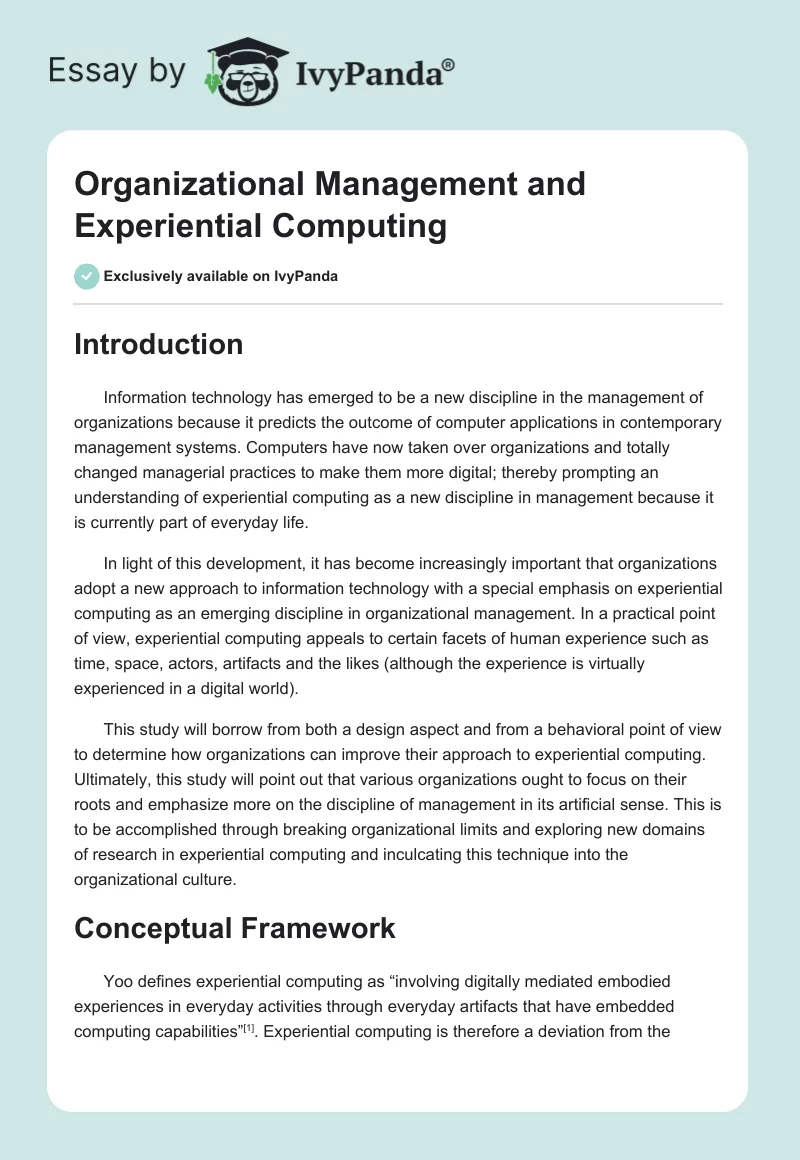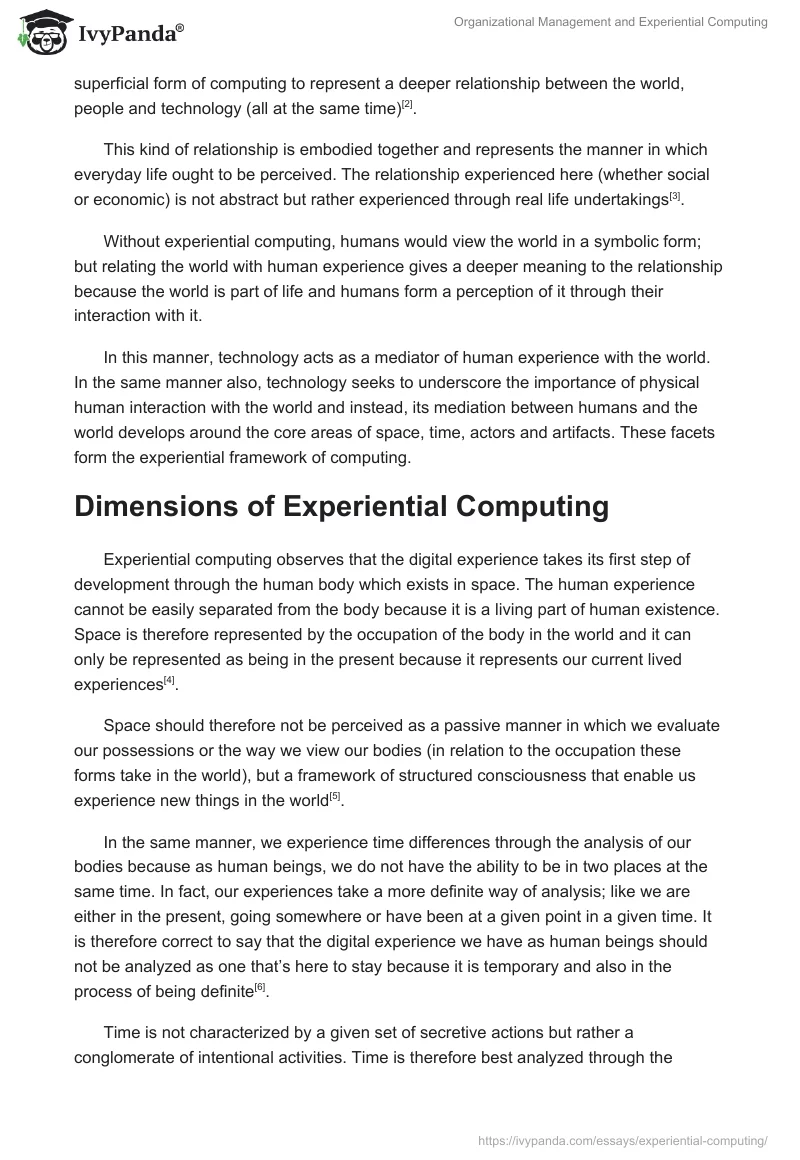Introduction
Information technology has emerged to be a new discipline in the management of organizations because it predicts the outcome of computer applications in contemporary management systems. Computers have now taken over organizations and totally changed managerial practices to make them more digital; thereby prompting an understanding of experiential computing as a new discipline in management because it is currently part of everyday life.
In light of this development, it has become increasingly important that organizations adopt a new approach to information technology with a special emphasis on experiential computing as an emerging discipline in organizational management. In a practical point of view, experiential computing appeals to certain facets of human experience such as time, space, actors, artifacts and the likes (although the experience is virtually experienced in a digital world).
This study will borrow from both a design aspect and from a behavioral point of view to determine how organizations can improve their approach to experiential computing. Ultimately, this study will point out that various organizations ought to focus on their roots and emphasize more on the discipline of management in its artificial sense. This is to be accomplished through breaking organizational limits and exploring new domains of research in experiential computing and inculcating this technique into the organizational culture.
Conceptual Framework
Yoo defines experiential computing as “involving digitally mediated embodied experiences in everyday activities through everyday artifacts that have embedded computing capabilities”. Experiential computing is therefore a deviation from the superficial form of computing to represent a deeper relationship between the world, people and technology (all at the same time).
This kind of relationship is embodied together and represents the manner in which everyday life ought to be perceived. The relationship experienced here (whether social or economic) is not abstract but rather experienced through real life undertakings.
Without experiential computing, humans would view the world in a symbolic form; but relating the world with human experience gives a deeper meaning to the relationship because the world is part of life and humans form a perception of it through their interaction with it.
In this manner, technology acts as a mediator of human experience with the world. In the same manner also, technology seeks to underscore the importance of physical human interaction with the world and instead, its mediation between humans and the world develops around the core areas of space, time, actors and artifacts. These facets form the experiential framework of computing.
Dimensions of Experiential Computing
Experiential computing observes that the digital experience takes its first step of development through the human body which exists in space. The human experience cannot be easily separated from the body because it is a living part of human existence. Space is therefore represented by the occupation of the body in the world and it can only be represented as being in the present because it represents our current lived experiences.
Space should therefore not be perceived as a passive manner in which we evaluate our possessions or the way we view our bodies (in relation to the occupation these forms take in the world), but a framework of structured consciousness that enable us experience new things in the world.
In the same manner, we experience time differences through the analysis of our bodies because as human beings, we do not have the ability to be in two places at the same time. In fact, our experiences take a more definite way of analysis; like we are either in the present, going somewhere or have been at a given point in a given time. It is therefore correct to say that the digital experience we have as human beings should not be analyzed as one that’s here to stay because it is temporary and also in the process of being definite.
Time is not characterized by a given set of secretive actions but rather a conglomerate of intentional activities. Time is therefore best analyzed through the comprehension of the difference in our expectations and the experiences we have undergone as human beings (in the past). Through these experiences in this time frame, we experience other social actors in our analysis who bring us to another important facet of experiential computing which is core artifacts.
Experiential experience makes us digitalize artifacts through the development of simple forms of tagging such as RGIS chips or through the use of bar codes and other similar type of networks, within a spectrum of simple and sophisticated applications.
The digitalization process can take the form of a simple mobile device or embedded sensors which memorize data such as of an object (like a cup) which the user can therefore interact with through digital experience. In addition, users can enjoy mixed experiences through the Web 2.0 services which mean that different artifacts can be sourced and mixed in a simple manner to share the experience of different users with different artifacts.
For instance, the digitalization of actors has been greatly facilitated in the recent past through an upsurge of social networking sites like tweeter, myspace and facebook which enable users to share information, pictures and the likes (thereby interacting with different social artifacts).
The kind of relationships observed in such kind of social networking sites are not ordinary because they represent an exclusive kind of interaction; like a professional interaction, as can be evidenced through linkedIn. Moreover, users or participants in these kinds of social networking sites can be expanded from the basis of friendly associations to group affiliations.
At present, there are already existing relationships which are not only based on friendships but on locations as well. In the same manner, there have been other similar organizations like the association of people doing the same kind of activity in the same time period (association of time); the association of people on the basis of artifacts, or people who use the same type of tool for trade and the association of people based on a mixture of any of the above two criteria.
For instance, DOPPLR has been singled out to be the leading social networking site that best links users based on the element of similar travel destination in addition to the capability of linking its users or their friends to other existing social networking sites.
Experiential computing has found its foothold on the above basis for digitalization and it practically encompasses most or all facets of human interaction. In fact, most of the users or actors in this digitalized world have all internalized the system because of the acknowledgement that technology is part of our day-to-day lives.
From the above example of social networking sites, most human interactions within the context of business operations can almost entirely be done online. This includes the ordering process, purchasing, payments, and delivery. It is therefore quite difficult for such users to view experiential computing as any different from everyday operations.
In the same manner, considering current trends, the hype related with computers will be absolved within the context of experiential computing. In this manner, computers will be used in devices like music players, cars, office desks but they will not be in the open for everyone to see because this new paradigm (experiential computing) in an organizational context is not to represent the world but to develop a newer and efficient world whereby everyone can take part in it with pleasure.
In this respect, the computing aspects are actually given real life forms, stored, and created in experiential computing through the involvement of conventional tools such as actors, artifacts or even through different locations. In this regard therefore, computing should not be perceived as an external factor to our existence but part of our day-to-day lives.
Conclusion
Experience is an important part to the existence of any human being an indeed the success of any organization. In fact, through the experience we hold, we are able to inculcate specific ideals, values and principles within ourselves.
In this study, we explore how organizations should take note of the fact that digitalization has the potential of transforming daily experiences because of its potential in merging human relationships with the real world. Many of the elements outlined in this study, such as space, artifacts, actors, and activities can all be of high importance especially in the analysis of information technology in organizations because they converge radical human experiences in a digital manner.
Bibliography
Goldin, D. Interactive Computation: The New Paradigm. Routledge, London, 2006.
Meister, J. Computing Action: A Narratological Approach. Walter de Gruyter, London, 2003.
Silberman, M. The Handbook of Experiential Learning. John Wiley and Sons, New York, 2007.
Tedre, M. The Development of Computer Science: A Sociocultural Perspective. Matti Tedre, Amsterdam, 2006.
Yoo. Y. Computing in Everyday life. Temple University, Philadelphia, 2009.


